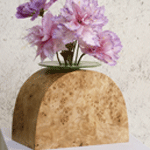Twenty-seven Woods
for a Chinese Artificial Flower
Art is born in the world as an offering, oblation, “sacrifice”. If on the way it has lost the connotations of sacredness, escaping magic coercion, when manifested, it is possible to retrace its origins, by following the traces of its path. These traces can at times become invisible or uncertain to the sacrificer himself, the author.
Sottsass, who proclaims to be secular, has never failed to question himself about the nature and boundaries of the “sacred”. But precisely ambiguity is intrinsic to the nature of art, as it is to that of the sacred.
“Twenty-seven woods for a Chinese artificial flower” implicitly declares itself to be an offering, a debt, a “sacrifice”, starting with its name-title.
The exhibition has an antecedent. Its antecedent is a vision, to which was added another, in confirmation, at a distance in space and time.
1st antecedent: Thailand, early 1960s. In the countryside outside Bangkok, a long wooden construction built on piles, inhabited by young Buddhist monks. The house has numerous very small windows and is immersed in silence, poised in the stillness of the afternoon heat.
Sottsass starts with surprise. He see a small window with a white gauze curtain drawn to one side. On the window-sill a vase with a lotus flower in it. Hanging from a thread, above the flower, a model propelled- aeroplane , perhaps a toy. The surprise turned into a thunderclap.
Says Sottsass: “ I have always carried around with me that vision of utter poetry, made of nothing, only of a special care of life”.
Sottsass has written repeatedly and at length about his travel. But he has never mentioned this story, as if the little window looking out onto the world were really a “total” vision of the world, a secret anchor of salvation, too solid for him ever to imaging abandoning it to the vicissitudes of the written word. The debt was too heavy; it had to be paid differently, at the appropriate time.
2nd antecedent: China 1993. On a secondary road, a tiny Chinese supermarket invaded by coloured paper flowers. The colours are vaguely unreal but gentle, like the flowers.
Same care and kindness as in the Thai window. Lightness, translucid transparency, emptiness. Magic entails a universal resonance.
Sottsass was to return two years later to China, to look for the paper flowers. He thought flowers made and painted by hand are “twice kind”. Those who use them do not watch the death of a flower. The victim has escaped the sacrificial stake. Its roots are still firmly buried in the earth.
“Twenty-seven woods for a Chinese artificial flower “ ideally follows up the exhibition of 1992, again at the Design Gallery Milano, entitled “Ruins”.
“Ruins” and the text that accompanied them, marked a declaration of impotence before the path of design, before “doing something different and more “ in the world.
The “Twenty-seven woods…..” state that after the ruins, after the impotence, there remains the ardour of emptiness, the origin of all power that precedes the “name”. The name is in itself a dismemberment, an offering that can also be called art or poetry.
It is the continual reinvention of rite.
Like the Thai window, like the paper in the Chinese supermarket, “Twenty-seven woods….” Will leave a trace, an “active leftover”.
The “active leftover” is a continuation of the world.
Barbara Radice, 1995










